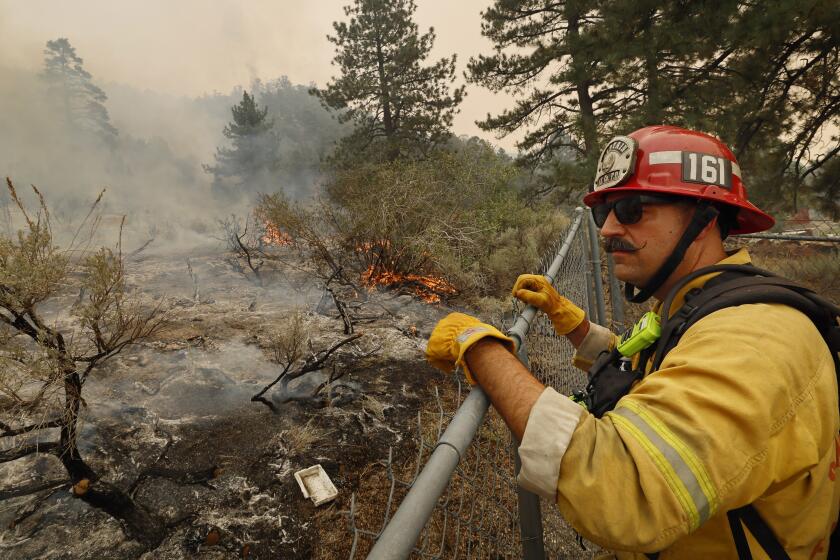From the Archives: Los Angeles Times Interview : James Bascue
His words are as carefully measured as his white shirt. But the image of judicious restraint is somewhat deceptive. Los Angeles Superior Court Judge James A. Bascue is candid, even outspoken, about the crushing caseload pressure California’s “three strikes and you’re out” law and the state budgetary squeeze are putting on local courts. A former prosecutor, Bascue also worries whether, by virtually eliminating opportunities for rehabilitation, California is getting so tough on crime that it risks abandoning a generation of youthful offenders.
As supervising judge of the Criminal Division, Bascue, 55, oversees the largest criminal court of general jurisdiction in the nation. He hears some 60 matters each morning, assigning trials among 39 judges downtown. When they are occupied, he can draw on the services of most of the 238 Superior Court judges, if necessary. Bascue also supervises the grand jury and sets countywide criminal policy on issues from the representation of indigent defendants to courthouse security and media coverage. As chair of the Countywide Criminal Justice Coordinating Committee, Bascue helped produce a report last year outlining the dramatic negative impact of “three strikes” on civil and criminal courts. The report’s cover was framed with cracking Ionic columns--the symbolism was intentional.
Before Gov. George Deukmejian appointed him to the court in 1990, Bascue had spent 16 years as a prosecutor with the Los Angeles district attorney’s office, where he helped create the Hard Core Gang Unit.
The judge and his wife, Superior Court Judge Jacqueline Connor, have two young sons. He escapes the stories of violence and tragedy that permeate the courthouse in visits to his vacation home in Northern California--he has planted more than 8,000 trees on his property there in the last four years.
Bascue was interviewed in a conference room on the 13th floor of the Criminal Courts Building. In the courtroom outside, bailiffs and television reporters awaited the expected surrender of a defendant. Nearby, a new judge paced, eager for Bascue’s advice on sentencing in a criminal case. Bascue noted, with characteristic understatement, “You have to be pretty well-organized to get through the day.”
*
Question: “Three strikes and you’re out” has been the law for two years. Certainly, some of the state’s worst criminals are behind bars, possibly for 25 years to life. Many would say the law is working exactly as it should.
Answer: Anyone with common sense would understand that when you incapacitate or lock up a recidivist offender, he or she is not going to be able to commit a crime in the community. And a long-term analysis of how well it’s working . . . will take time. But certainly short-term in Los Angeles County, we’ve had some tremendous burdens placed upon us. We’ve had a 25% increase in our jury-trial rate. . . . Every corner of the justice system has been impacted by three strikes, and if you’ve got no additional resources, that means you’re going to have to stop doing something you were doing to accommodate the third-strike cases.
Q: And the something that you’re not doing now is?
A: Well, we’re displacing our civil cases. . . . We had made great strides before three strikes to reduce the time it takes to get a civil case heard--and now there is delay after delay in our civil cases. In some instances and in some districts, such as in Pomona, virtually no civil cases are being heard--and if they are being heard, they are greatly delayed.
Q: Some people have argued that the three-strikes law is too harsh. An individual convicted of stealing meat to feed his children, if it is his third felony conviction, now goes to prison for 25 years to life. Is this too harsh?
A: This law has been challenged under the cruel-and-unusual-punishment provision. The appellate courts have held that it’s not violative of that constitutional provision. . . . But the statute appears to vest the discretion of charging and/or striking strikes in the prosecutor. And many bench officers will see a case in front of them where they are very concerned that the prosecutor has not exercised his or her discretion appropriately in filing or in not trying to settle the case. Judges are extremely concerned about sentencing someone to 25 years to life in certain types of cases. But that is the law at this time. And as to whether or not the trial-court judges have the discretion to strike is pending before the state Supreme Court.
Q: San Francisco’s Dist. Atty. Terence Hallinan recently said he would no longer prosecute nonviolent offenses under the three-strikes law. You were a deputy district attorney, would you advise Dist. Atty. Gil Garcetti to do the same?
A: Well, we’ve met with Dist. Atty. Garcetti and he’s indicated that he is following the law and the will of the people. . . . My concern is that this is a very large county and whether your case gets filed and gets settled, many times is determined by which court you’re in, which district attorney is hearing it . . . In a smaller jurisdiction, it may be easier for the district attorney to implement an even-handed policy. In the county of Los Angeles, . . . there are, in my opinion, instances where the law is inappropriately enforced . . . .
There are instances where you’ve got a violent, recidivist offender and the new offense is a nonviolent felony . . . The three-strikes law means to go after the recidivist offender who is impacting the community. So you may only have a cocaine-possession case--but the defendant was just out on parole for rape, just out on parole recently for burglary or robbery. You can’t say all nonviolent cases should never be handled as strike cases. What you need is a realistic filing policy and settlement policy, looking at each case on a case-by-case basis.
Q: And the law does not allow prosecutors to do that at this point?
A: In my opinion it does. The law vests so much discretion in the prosecutor . . . in what cases they will file and what cases they will settle.
Q: Recent evidence indicates there has been a drop in the crime rate in California and other states. Does tougher sentencing have anything to do with this?
A: . . . I think we’re in a lull. Certainly, adult crime is down, somewhat. Is that attributable to three strikes? I doubt it . . . . From my lockup, I see inmates aware of the three-strikes law; . . . I think it’s going to take a while for that to have an impact--which I think it will. Some of the drop is just cyclical, it may go back up at some point. But the crime rate that is certainly on the rise is the youthful offender--from about 13 to 17 or 18 years old. That age group is the most violent and most recidivist by nature.
Q: Are you comfortable with the new proposals Gov. Wilson has made and Dist. Atty. Garcetti has endorsed to get tougher on juvenile offenders, in particular, to try more of them as adults, to give them fewer breaks?
A: I’m not fully aware of all of the measures, but, clearly, identifying the youthful offenders as a danger to the community is appropriate. I was in charge of the Hard Core Gang Unit in the district attorney’s office, and there was never a question in my mind as to who the most dangerous people were: It was these youthful offenders. But I am concerned about the legislation that would place the discretion to file a 14-year-old youthful offender directly into the Superior Court in the hands of the prosecutor.
Q: Why?
A: That is a judicial decision. Historically, we’ve treated youthful offenders almost like a family court--parens patriae was the original concept and we’ve been moving away from that. . . . I don’t see any reason to take that authority away. It has not been pointed out to me that there have been any abuses, or the prosecutors are not getting the appropriate cases held to answer. It seems to me to be taking a lot of due process away from the youthful offender and putting almost just unfettered discretion in the hands of the prosecuting attorney as an advocate.
Q: Why should the public care whether judges have less discretion in sentencing than they had before, either under three strikes or some of these proposals with respect to youthful offenders--especially now when crime is supposedly down? It might seem that taking discretion away from judges is successful as far as the public is concerned.
A: There is no doubt that the crime issue is driving the community and they have a right to be extremely concerned about it. But we have a right to expect a rational response . . . . Judicial officers are there to be independent, to be fair and neutral. If you start taking decision-making away from judges, you’re placing it in the hands of an advocate with, if you will, a predetermined outcome. What is happening here is a further erosion of the concept of separation of powers, where the judicial branch is an independent branch of government; it is there to be an entity that exercises discretion to protect the rights of both parties. You start vesting discretion in just one advocate’s side, such as the prosecuting attorney, you really will lose the neutrality and unbiased arbiter to provide the kind of justice that our community expects.
Q: How do the courts regain some control?
A: The courts, historically, have been apolitical, have not wanted to get involved in the political process, and lawyers have, historically, understood the importance of an independent, separate court system as a branch of government. That has changed. The Legislature is not dominated by lawyers anymore, and many lay people have forgotten their civics lessons and want to treat the court as just another agency in state government, or another department in county government. A lot of them need to go back and take a look at Civics 1 and try and understand why the founding fathers felt it necessary to have the courts as an independent branch of government--to protect the separation of powers. We, the court, has to educate the public and let them know the importance of being a separate branch of government.
Q: You and other judges have predicted that the county’s budget crisis will mean that L.A. Superior Court will run out of money this month. What is the status of the budget shortfall?
A: We still have a crisis involving our budget. I’ve been informed by our executive officer that we have . . . about a $7-million-plus shortfall that the court is going to have to take some form of action to alleviate.
Q: Are you concerned that courthouses may close?
A: Courthouses closing is an option that has been discussed.
Q: When will this shortfall actually hit the courts?
A: We’re starting to experience it now. It will have to be addressed this month or next month.
Q: How are you starting to experience it?
A: By experience it, I mean that the presiding judge and the executive officer are now in a planning stage knowing that there is not enough money to run the court through this fiscal year. They are meeting on this and coming up with strategies.
Q: Where is the court or the county going to get additional money?
A: The state agreed to fund the courts throughout the state at the level of 70%, the county to fund 30%. Unfortunately, the state has not honored its agreed-to obligation, and it’s been almost the converse in the last few years. The county has had to pick up almost 70% and the remainder by the state government. The county is just as much a victim in this instance as is the Superior Court. The state has not honored its obligation.
More to Read
Sign up for Essential California
The most important California stories and recommendations in your inbox every morning.
You may occasionally receive promotional content from the Los Angeles Times.










